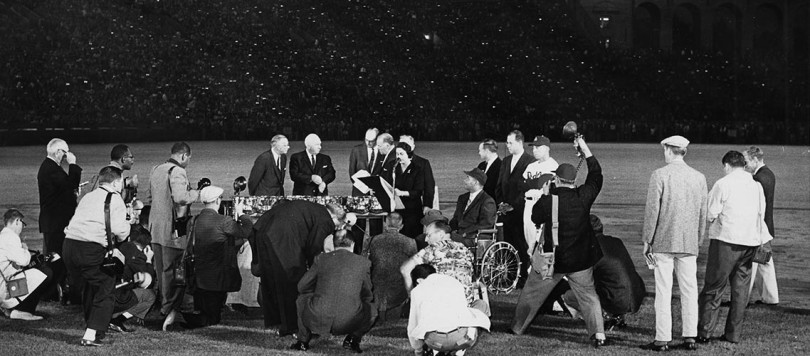
Roz Wyman, Los Angeles City Councilwoman from the Fifth District, extends the council’s best wishes to Roy Campanella as part of an in-game tribute to him on May 7, 1959. A baseball fan for many years, Wyman was the driving force in attracting the Dodgers to Los Angeles from Brooklyn.
Feature
A Tribute to Roy Campanella Remembering A Hero
By Brent Shyer
Originally Published on May 7, 2009
American icon Roy Campanella, whose courageous life’s story inspired countless others to lift themselves up in the face of adversity, will be remembered this week on the 50th Anniversary of special recognition in his honor.
“Roy Campanella Night,” a dramatic and unforgettable tribute to his strength during the most challenging times, was held on May 7, 1959 before 93,103 fans, a major league record crowd, at the Los Angeles Memorial Coliseum. It is awe-inspiring to consider that a sell-out crowd, with more than 15,000 more turned away at the gates, showed up for former Brooklyn Dodger catcher Campanella, who had been paralyzed at 36 years old in a single-car accident in 1958, and never had the opportunity to play a game in Los Angeles. Yet, all of those fans wanted to partake in the ceremonies during an exhibition game between the Dodgers and the New York Yankees. The attendance record stood for 49 years.
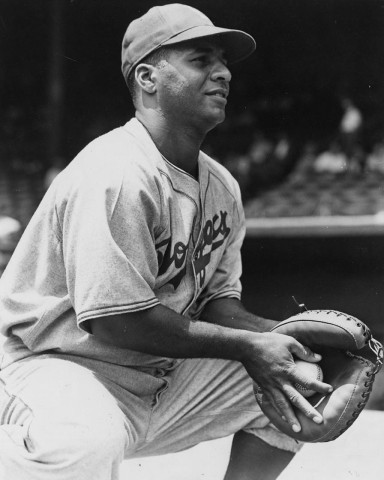
A pillar of strength, catcher Roy Campanella joined the Brooklyn Dodgers for the 1948 season following a stint in their minor league system with Nashua, NH and Montreal. As one of the first four African-Americans to be signed into Major League Baseball, Campanella was well-prepared for the opportunity having previously played in the Negro Leagues and Mexican League.
This Thursday, May 7, Roy’s daughter Joni Roan is scheduled to throw the ceremonial first pitch prior to a game at Dodger Stadium to recall the historic event.
Dodger owner Walter O’Malley arranged for this special evening to honor Campanella and it was much appreciated by his former three-time National League MVP. “A lot of people didn’t know the man (O’Malley) for what he was,” said Campy. “He stood by me every minute after my accident, helping me to see my way through. No one knows that after that wonderful night he had for me in the Coliseum when 93,000 showed up, he gave me a check for $50,000. And he continued my salary, which was more than $50,000 a year, for years after that. He was a great pioneer in integrating baseball.” Los Angeles Times, August 10, 1979
O’Malley worked for a long time in formulating the concept of a series of exhibition games with the Yankees. Originally, the game was suggested by the Hearst Newspapers in New York. Later, O’Malley and Yankees’ owner Del Webb, along with executives E.J. “Buzzie” Bavasi, Dan Topping and George Weiss, worked out arrangements to play a game in Los Angeles. O’Malley agreed to pay the Yankees their travel expenses and approximately $85,000 for the trip. He also provided Campanella with one-half of the proceeds from the game, setting up an account with the three-time MVP catcher’s attorney to safeguard the funds.
In a tough travel schedule, the Dodgers played a regular-season game on the afternoon of May 7 in San Francisco, defeating the Giants, 2-1 at Seals Stadium, flew back to Los Angeles to play the night exhibition contest, losing to the Yankees, 6-2 and then returned to San Francisco for the next night’s game.
But, Campanella’s inspiring story began years before the tribute game.
From the time he was seven, Campanella grew up amongst the row houses in the Nicetown section of Philadelphia, which in the 1920s was filled largely with Polish and Italian immigrants. In the neighborhood, he began to hear the taunts of other children who called him "half-breed," as he was the son of an African-American mother named Ida and an Italian-American father named John. It was just the beginning of lifelong struggles for a star athlete who could only dream of playing baseball professionally — in the Negro Leagues, that is. At the tender age of 15, Campanella was spotted and signed by the Baltimore Elite Giants from the Bacharach Giants, a Negro semi-pro team in Philadelphia, for whom his mother had given him permission to play a few games as a part-time catcher.
Campanella had to overcome persistent prejudice that all African-Americans of his era endured, but he never let that deter him from playing baseball, the game he truly loved with all his heart and soul.
Just one year after legendary Jackie Robinson shattered baseball’s color barrier for African-Americans in the “Great Experiment” of 1947, Campanella joined the Brooklyn Dodgers. The Dodgers had won the 1947 National League Pennant. By then, the multi-talented 26-year-old had toiled for years with the Elite Giants and had a brief stint in the Mexican League, before Robinson’s turn-the-other-cheek mentality created an opening for other selected African-Americans to play in the majors. But this was no token addition to the Dodgers.
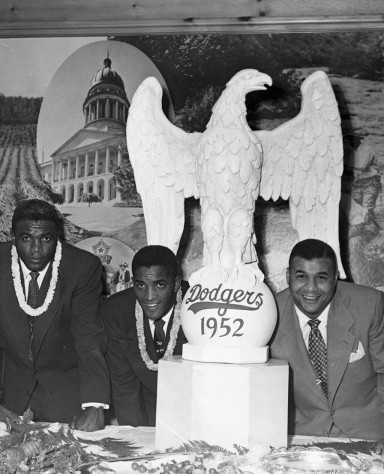
Roy Campanella (far right) celebrating with teammates Jackie Robinson (left) and Joe Black at the Brooklyn Dodgers’ 1952 National League Pennant victory party at the Hotel Bossert.
In 1946, Campy and African-American pitcher Don Newcombe celebrated their first year of “organized baseball” at Nashua, New Hampshire. Campy, who earned $185 a month, performed admirably, causing Dodger President Branch Rickey to advance him to the International League’s Montreal Royals roster for 1947. By 1948, Campanella was promoted to the Dodgers, while his roommate “Big Newk” made his debut in 1949. Campanella was the fourth African-American signed to a contract in “organized baseball” following Robinson, John Wright and Newcombe. He became the first black catcher in Major League Baseball history. In late May of 1948, the Dodgers briefly sent Campy to their St. Paul, MN farm team where he integrated the American Association before his permanent return to the majors.
Well-prepared for the daunting task, Campy delivered (just as he had on his milk route when, as a youngster, he got up at 2 a.m. to make his rounds) and produced big time — 10 successful seasons, helping to lead the Dodgers to five National League Pennants (in 1949, 1952, 1953, 1955 and 1956) and their first and only World Championship in Brooklyn in 1955.
As teammate Newcombe said about the dawn of the civil rights movement. “Martin Luther King once told me, ‘You’ll never know what you and Jackie (Robinson) and Roy (Campanella) did to make it possible to do my job.’”
Campanella was a mainstay handling the deft Dodger pitching staffs, which included the likes of Newcombe, Carl Erskine, Clem Labine, Preacher Roe, Johnny Podres and Ralph Branca. But, it was on offense where Campanella also shined with his powerful swing. Seldom was he cheated at home plate. Campy was rewarded with National League All-Star status on eight occasions.
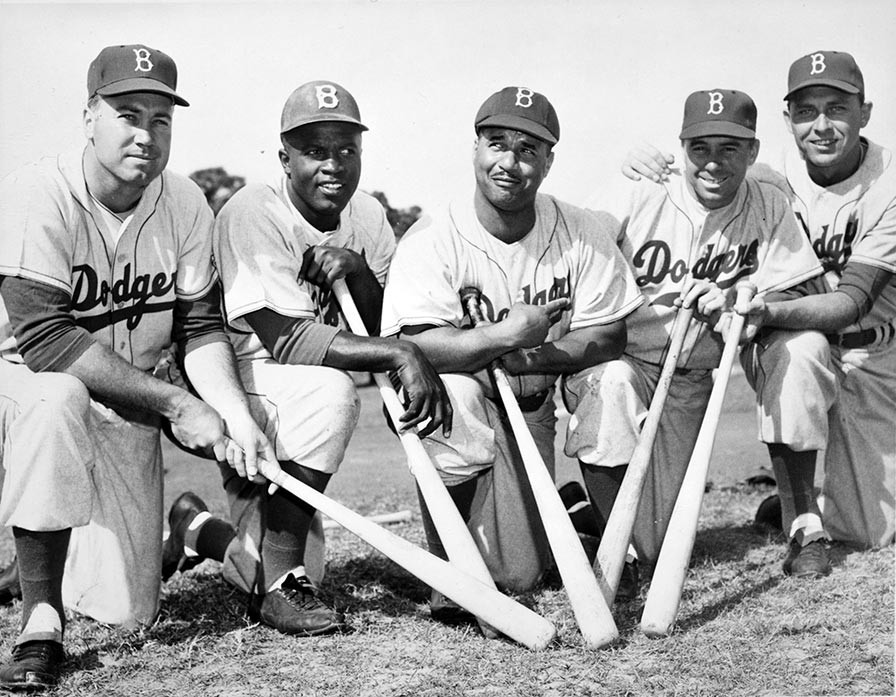
A quintet of Brooklyn Dodgers, all of whom were inducted into the National Baseball Hall of Fame, made significant contributions to the game and helped shape the course of Dodger history. Shown from left to right are Duke Snider, Jackie Robinson, Roy Campanella, “The Captain” Pee Wee Reese and Gil Hodges.
Three specific seasons stand out in his Dodger career — 1951, 1953 and 1955. In each of those years, Campy was honored with the National League Most Valuable Player Award. In 1951, Campanella batted .325 with 33 home runs and 108 RBI; in 1953, he set single-season records for catchers with 41 home runs and 142 RBI, tops in the National League, while batting .312. In the Dodgers’ World Championship season of 1955, once again Campy distinguished himself as a leader with a .318 average, 32 home runs and 107 RBI.With the broad shoulders and steady hands of Campanella adroitly guiding the way behind the plate, Dodger pitching staffs led the National League in earned run average in 1955 (3.68) and 1957 (3.35).
In his stellar 10-year career, Campanella batted .276 with 1,161 hits, 242 home runs and 856 RBI. Six times he led National League catchers in putouts.
Yet, the character of the 5-foot-9 ½, 200-pound Campanella should not be measured in statistics alone. He was a rock behind the plate, respected by his opponents, revered by his teammates and a man of inspiration in the clubhouse. His unique storytelling style led to one of the most famous areas of Dodgertown, the longtime spring training home of the Dodgers in Vero Beach, Florida, where “Campy’s Bullpen” was established. This was a bench just outside the old Dodger kitchen and clubhouse where Campy would spin yarns, talk baseball and about life with captivated young players and veterans alike.
Walter O’Malley succeeded Rickey as Dodger President on October 26, 1950. With such high regard for the graceful Campanella and the catcher’s leadership qualities, O’Malley informed him in 1953 that when his playing career was over, Campy would begin his managerial career with a guaranteed position in the Dodger minor league system.
On March 4, 1954, with Campanella in the driver’s seat and O’Malley as a passenger, Roy drove a car onto the playing field at Dodgertown during a Dodger intra-squad game, honking the horn and bringing the action to a standstill, just as George “Shotgun” Shuba had doubled down the right field line and pulled into second base in the fourth inning. The game was interrupted as Campy wanted to show his proud teammates the car he had purchased for $7,000. After a few minutes and some photographs, Campy and O’Malley drove off the field and play resumed (with Campy returning to the field to serve as “batboy” for the game).
When tragedy struck the life of Campanella, it was O’Malley who would assist him and his family in unique ways.
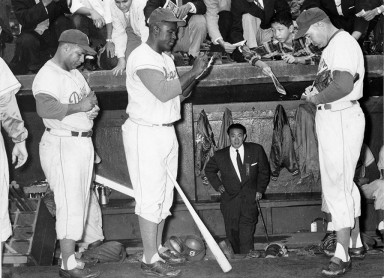
Popular Dodgers Roy Campanella, Jackie Robinson and Duke Snider sign autographs for their many fans during Brooklyn’s Goodwill Tour to Japan in October-November, 1956.
As the curtain descended on a disappointing 1957 Dodger season, O’Malley made his biggest business decision. His decade-long effort to gain the support of elected officials to assemble land at the intersection of Atlantic and Flatbush Avenues in Brooklyn, where he would have built baseball’s first dome stadium, came to an end. On October 8, 1957, the Dodgers announced they were heading to Los Angeles.
O’Malley had visited Los Angeles on just three previous occasions before relocating there (on a stopover in October 1956 en route to the Brooklyn Dodgers Goodwill Tour to Japan; in January of 1957 after he purchased a Convair 440 airplane for Dodger flights; and in May of 1957 to view possible sites to privately build a baseball stadium). In January 1958, O’Malley’s focus was where the Dodgers would play in Los Angeles come April — the Pasadena Rose Bowl, the mammoth Los Angeles Memorial Coliseum or at Wrigley Field, the home of the defunct Pacific Coast League Los Angeles Angels, then owned by the Dodgers.
It came as a shock to O’Malley, as well as the rest of the baseball world, that on January 28, 1958, as Campanella was driving home late from working and closing for the night his Harlem liquor store, his car slid uncontrollably off an icy patch on the road, ran directly into a telephone pole and then overturned, leaving the 36-year-old paralyzed from the neck down with two fractured vertebrae.
At that moment, Campanella’s life would change forever.
Five doctors fought feverishly through the early morning hours to save his life in a four-and-a-half hour operation at Glen Cove Community Hospital in Long Island, New York. While some might have been bitter and blamed the world for a debilitating accident, this sturdy athlete decided to fight back with all his might, going into therapy at Rusk Institute of the New York University-Bellevue Medical Center to try to return to his “normal” routine. However, all of his hard work and determination would suffer another unexpected setback.
Death stared Campanella down once again nearly one year after his first auto accident. On January 19, 1959 an air compressor separated from a truck on the Long Island Expressway, tumbled over a divider and hit the car in which he was a passenger nearly head-on. Visibly and violently shaken internally once more, Campy again refused to let anything stop him from living his life optimistically. He was determined to stay alive. His indomitable spirit and character untouched, Campanella survived the second car crash and continued his rigid rehabilitation regimen.
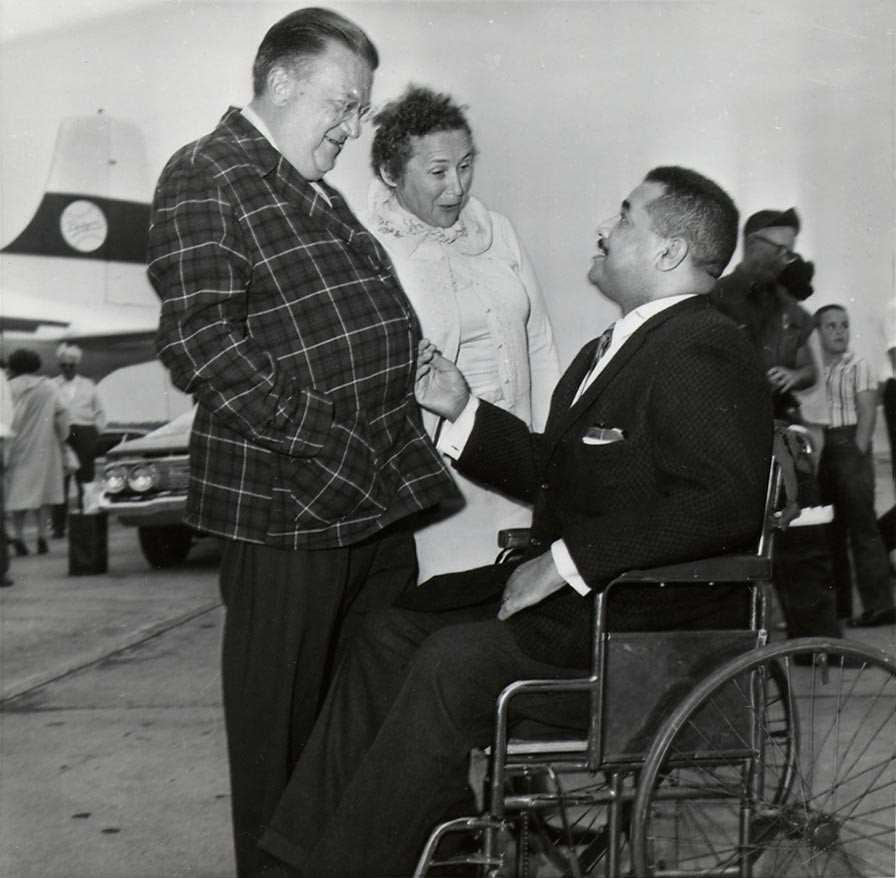
Walter and Kay O’Malley with Roy Campanella at the Vero Beach airport. Taken circa 1959.
Just weeks later, during Spring Training, O’Malley invited Campanella to visit his friends and teammates at Dodgertown. Campanella describes what happened next in his 1959 autobiography, “It’s Good to be Alive” on March 5 of that year.
“I was having breakfast in the club dining room when Mr. O’Malley came in and whispered something to me. Roy, I’d like you to be in the press room at four o’clock today...It’s important. That’s all. He didn’t say what it was about or why he wanted me there...I had no idea what it was all about, but I spent the next few hours trying to figure it out. I thought, of course, it had something to do with the team. I had been working with Johnny Roseboro, teaching him the little extra tricks of catching. The Dodgers had a lot of young pitchers in camp, and I thought maybe they wanted me to work with them. I couldn’t imagine anything else.
“Anyway, at five minutes to four, I wheeled myself into the press room. The room was filled with reporters. Mr. O’Malley was at the head of the press table. Seated around him were Manager (Walter) Alston; my old buddy Pee Wee Reese, now a coach; Carl Erskine, who was the team’s player representative; and Red Patterson, the club’s publicity man. As soon as I arrived, Mr. O’Malley arose, walked over to me and handed me a sheet of paper. ‘Roy,’ he said, ‘read this, and if it’s all right with you I’ll make the announcement.’
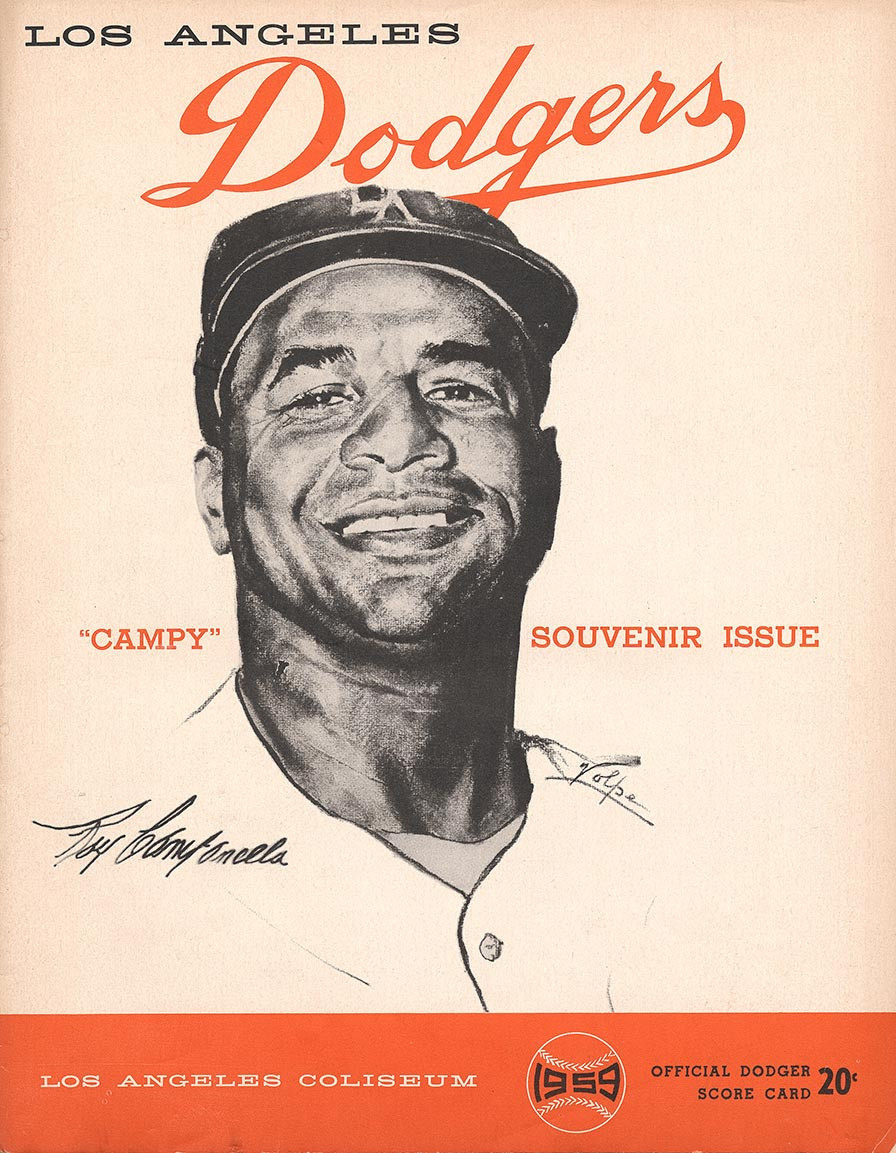
The souvenir scorecard from “Roy Campanella Night” at the Los Angeles Memorial Coliseum features a drawing of “Campy” in his “LA” cap by renowned artist Nicholas Volpe on the cover.
“It was just one paragraph, but I had to read it twice to make sure I was reading it right. Even when I finished reading it a second time, I still couldn’t believe it. I was never so touched before. Tears came to my eyes. Finally, I looked up at Mr. O’Malley and asked, ‘What am I supposed to say?’ ‘Just say if it’s all right with you,’ he said. ‘Certainly it’s all right with me,’ I said, ‘and I also want to say thank you with all my heart. This is wonderful, just wonderful.’
“Mr. O’Malley then read the statement.” It’s Good To Be Alive by Roy Campanella, Copyright 1959, Little, Brown
What O’Malley announced was that the Dodgers had arranged for the World Champion New York Yankees to play a special exhibition game in Los Angeles during the regular season to pay tribute to Campanella. Even Baseball Commissioner Ford C. Frick had endorsed the goodwill gesture, as the Dodgers would be forced to return to L.A. from an afternoon game in San Francisco the same day. The night game was held on May 7, 1959, at the Dodgers’ temporary home, the Coliseum in Los Angeles. An emotional mid-game ceremony was held between first and second base. Former Dodger team captain Reese pushed the wheelchair in which Campy was seated to behind home plate as the crowd went wild.
One of the most poignant memories for those in attendance was when the crowd was asked to light a match in tribute to Campy. The sparkling lights from the matches and cigarette lighters made it appear as if there were thousands of fireflies dancing throughout the mammoth stadium. On the radio, Dodger broadcaster Vin Scully then asked the crowd to “say a prayer for his (Campy’s) well-being.”
The most important aspect of the tribute game (won 6-2 by the Yankees) was that Campanella had never played a game in Los Angeles and yet his reputation was so golden that fans wanted to honor him.
The game and tribute were considered a huge success. An appreciative Campanella once called O’Malley “a true pioneer who to me was like a father when I first came into the Dodger organization. He stood by me, and after my injury he stood by me and helped me through all of my crises.”
Campy’s wife Ruthe, though, could not bear to see her once strong, athletic husband in a paralyzed state and the upside down world it caused her and their family (three sons and two daughters). Unexpectedly, she had medical problems and Campanella later sued Ruthe for legal separation. But, he dropped the lawsuit and the marriage on the rocks continued (though they became estranged) until 40-year-old Ruthe died suddenly of a cerebral hemorrhage on January 25, 1963 while talking on the telephone.
The concerned O’Malley, however, would assist Campanella with his needs, ensuring that he had the necessary and proper care to move forward. For his part, Campy showed great inner strength, determination and maintained his sense of humor.
A year after Ruthe’s passing, Campanella married his next-door neighbor Roxie Doles, who served as his physical therapist and was his best friend for the next 30 years. With Roxie’s unwavering strength, always by his side, and the Dodgers firmly behind him, Campanella said they “helped me put my life back together.”
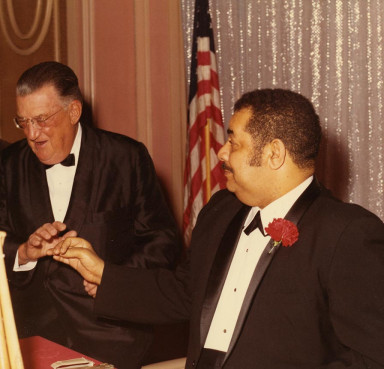
Walter O’Malley thought so highly of Campanella that he said in 1953 that he would guarantee him a position as a manager in the Dodger minor league system. Instead, following his debilitating automobile accident, O’Malley and his son, Peter, would offer Campy a position in the Dodger front office in Community Relations and as a special instructor to the organization’s catchers. He accepted and worked for the club from 1978 until his passing on June 26, 1993.
Campy reached the hallowed halls of Cooperstown, as he was inducted to the National Baseball Hall of Fame in 1969. In the Hall’s history, only 16 catchers (7 percent of all inductees, including this year’s Negro League inductees) have been recognized with the honor. On June 4, 1972, in ceremonies during Oldtimers Day festivities at Dodger Stadium, the O’Malley family permanently retired Campanella’s uniform number 39, along with those of Jackie Robinson (#42) and Sandy Koufax (#32).
Dodger Chairman of the Board Walter O’Malley and his son Peter (Dodger President) hired Campanella to represent the organization in its Community Relations Department in 1978. As he departed New York and relocated to Woodland Hills, California, Campanella stated, “This is as happy as I’ve ever been. I feel that even in this wheelchair I can help the Dodgers as much as I did with a bat and ball.” Campy continued in that post, as well as special instructor to catchers throughout the Dodger major and minor league system.
In 1991, he and Roxie established “The Roy and Roxie Campanella Physical Therapy Scholarship Foundation,” supporting those with paraplegia and awarding scholarships to students pursuing degrees in physical therapy. Campy remained with the Dodgers until his passing on June 26, 1993 at age 71. In April 2006, Campanella was inducted into the Philadelphia Sports Hall of Fame.
One of Campanella’s most recognized quotations is “You have to have a lot of little boy in you to play baseball for a living.” The U.S. Postal Service paid tribute to Campanella on July 15, 2006, when its “Baseball Sluggers” series was released, acknowledging the wide sphere of influence this man among men made on others and is yet another stamp of approval by his loyal admirers.
Once again, this week is a good time to reflect on his bountiful legacy.

